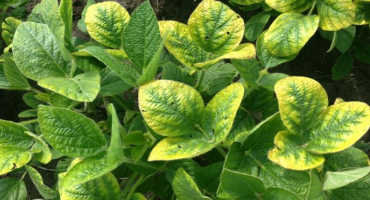By Emmanuel Byamukama
Some of the soybeans that were planted early or are early maturing varietes are starting to show color change. Color change around this time of the year indicates natural senescence where leaves progressively turn yellow and eventually drop off.
However, some portions of the soybean fields may show clusters of plants yellowing when the rest of the field is still green. Such yellowing areas in the field may indicate plant stress causing plants to prematurely yellow. One of the factors that could lead to soybean plants showing early yellowing in clusters is soybean cyst nematode (SCN) (Figure 1).
Figure 1. A drone image of a soybean field with plants starting to senesce prematurely due to SCN infection.
Symptoms and Identification
Green soybean plants with increasing yellowing around the edges of their leaves.
Figure 2. Potassium deficiency symptoms on soybean plants. Notice the heavy yellowing in the leaf margins. Courtesy: E. Byamukama
Soybeans showing early signs of senescing due to high SCN population density can be confused with other stress factors. Other factors that also cause early senescing include low soil moisture especially if the spot has a gravel patch or compaction, excessive moisture in case of low spots in the field, root rots such as charcoal rot or sudden death syndrome, stem rots such as brown stem rot (BSR) and white mold, and nutrient deficiency mainly potassium. Soybean plants yellowing due to SCN are likely to be found near field entrance areas, along the fence line or road, and low spot areas. These areas will also have stunted soybeans and incomplete canopy closure. Plants yellowing due to root rots will show rotting on roots and splitting of such tap root may reveal discoloration of the root cortex. Plants yellowing due to white mold will show cotton white mycelia on the stems while plants with BSR when stems are split reveal the brown discoloration of the stem pith. Potassium deficient plants have top leaves yellowing starting from the margins (Figure 2). It is important to diagnose what maybe causing the early senescence so appropriate management practices can be implemented the next time soybean is planted in the same area.

Figure 2. Potassium deficiency symptoms on soybean plants. Notice the heavy yellowing in the leaf margins.
Testing for SCN
Not every field that has SCN will show soybean senescing early in certain parts of the field and not every early senescing soybean field is due to SCN. Therefore, this should not be used to determine if a soybean field has SCN or to assess the population density. The best way to determine if a field has SCN is to submit a soil sample for SCN testing. This testing is free of charge to SD producers, courtesy of a grant from the SD Soybean Research and Promotion Council. Fall is the best time to take a soil sample for SCN testing since the end of season would indicate maximum SCN population development. To take a soil sample, use a soil probe or a spade and take 20 cores 0-8 inches in areas that are suspected for having SCN and each sample taken from each of a 15-20 acre sections within a field. These cores should be mixed well in a bucket then placed into a soil bag although a ziplock can be used if necessary. The sample can be dropped off or mailed to the SDSU Plant Diagnostic Clinic for testing:
Management Strategy
Fields found positive for SCN should be planted with SCN-resistant soybean varieties (rotate sources of resistance namely PI88788 and Peking), rotated away from soybeans, and a nematicide seed treatment should be used if SCN populations are high (>10,000 eggs/100 cc of soil).